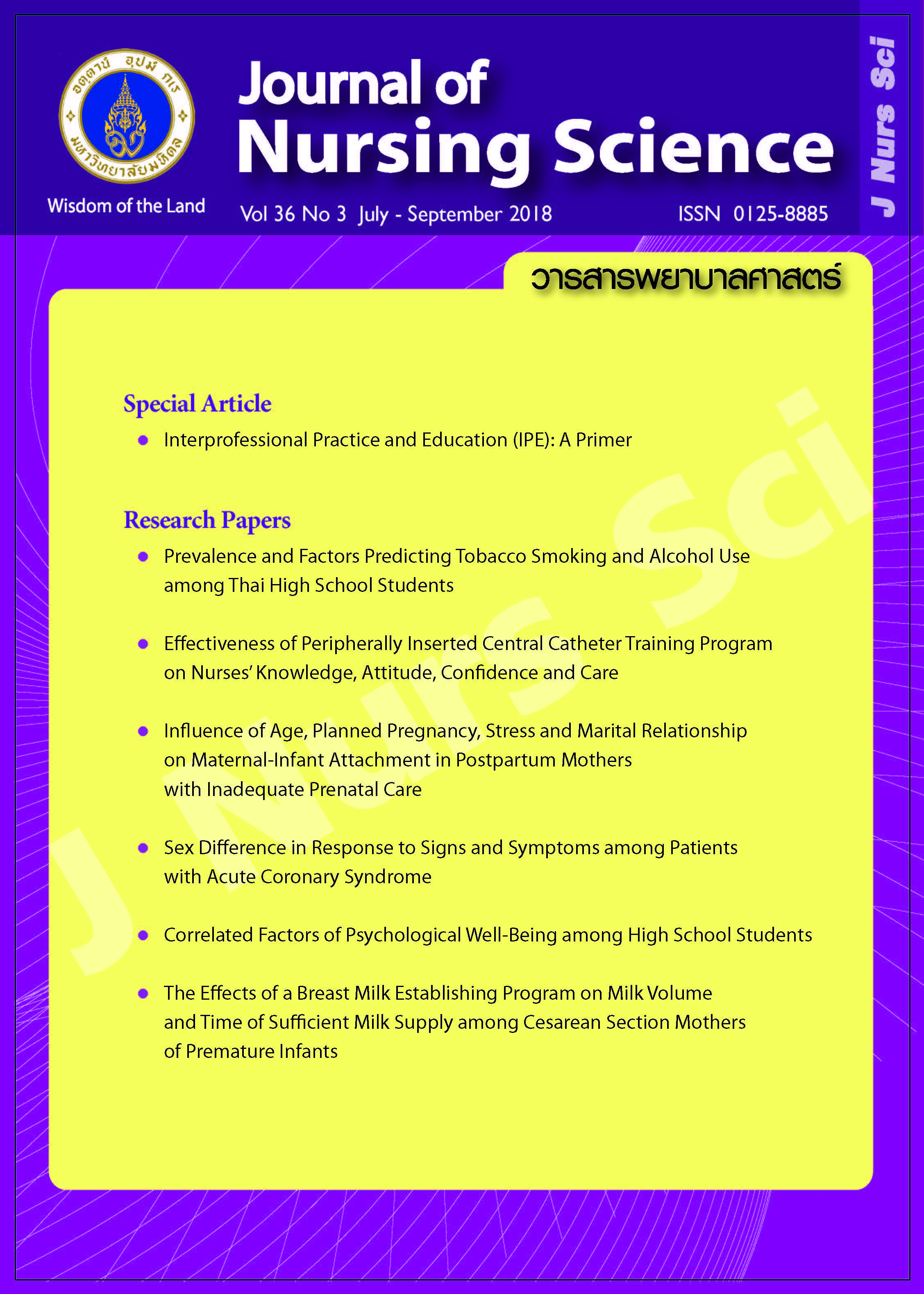Effectiveness of Peripherally Inserted Central Catheter Training Program on Nurses’ Knowledge, Attitude, Confidence and Care
Main Article Content
Abstract
Purpose: The study purpose was to determine the effects of peripherally inserted central catheter training program on knowledge, attitude, confidence and frequency of patient care among nurses.
Design: A quasi-experimental research.
Methods: The study sample included 60 nurses at Siriraj Hospital who took care of patients with peripherally inserted central catheter. The study subjects were divided into trained nurses who received the program and non-trained nurses who did not receive the program, with 30 each. Data collection was performed by using a demographic data form and a set of questionnaires: knowledge, attitudes, confidence and frequency of peripherally inserted central catheter care. Data were analyzed by chi-square test, paired sample t-test and independent sample t-test.
Main findings: For knowledge before receiving the training program, there was no difference between two groups. Average score of trained nurses’ knowledge at 6 months after the training was statistically higher than before the training (p < .01). The average scores of attitude and confidence of the trained group were significantly higher than that of the non-trained group (p < .05 and p < .01, respectively). For the average score of frequency of care, there was no significant difference between two groups.
Conclusions and recommendations: Training program on peripherally inserted central catheter patient care can increase knowledge, attitude, and confidence of the nurses. Therefore, continuous training should be provided to enable nurses to effectively provide care for the patients.
Article Details
Copyright Notice: Nursing Science Journal of Thailand has exclusive rights to publish and distribute the manuscript and all contents therein. Without the journal’s permission, the dissemination of the manuscript in another journal or online, and the reproduction of the manuscript for non-educational purpose are prohibited.

Disclaimer: The opinion expressed and figures provided in this journal, NSJT, are the sole responsibility of the authors. The editorial board bears no responsibility in this regard.
References
2. Hershey CO, Tomford JW, Mclaren CE, Porter DK, Cohen DI. The natural history of intravenous catheter-associated phlebitis. Arch Intern Med. 1984;144(7):1373-5.
3. Khanchai W. The factors associated with infusion phlebitis in surgical patients. Bangkok: Department of Nursing Siriraj Hospital Printing; 2006. (in Thai).
4. Krongkaeo K, Sukhonthawit P, Hunsai Y, Pittayapan P. Incidence of phlebitis in patients admitted at Siriraj hospital. Bulletin of Nosocomial Infection Control Group of Thailand. 2007;17(1):30-8.
5. Infusion Nurses Society. Infusion nursing standards of practice. J Infus Nurs. 2006;19(1 Suppl):S1-92.
6. Sawaadiwipachai P. Peripherally inserted central catheter [abstract]. In: International basic PICC line training; 2016 October 19; Siriraj Hospital, Bangkok, Thailand. Bangkok: Faculty of Medicine Siriraj Hospital Printing;
[2016]: p.1. (in Thai).
7. Royer T, Lang E, Neuzil K, Beneda H. Peripherally inserted central catheter (PICC) bloodstream infection surveillance rates in medical intensive care, medical surgical wards, extended care, and out patients. Am J Infect Control. 2005;33(5):15-6.
8. Baiocco GG, da Silva JL. The use of the peripherally inserted central catheter (PICC) in the hospital environment.
Rev Lat Am Enfermagem. 2010;18(6):1131-7.
9. Wu Z, Zhao J. The problem with peripherally inserted central catheters in China. Pak J Med Sci. 2013;29(3):896.
10. Rongrungruang Y. Infection control and management for PICC line [abstract]. In: Nursing care for PICC line training; 2017 January 27; Siriraj Hospital, Bangkok, Thailand. Bangkok: Faculty of Medicine Siriraj Hospital Printing; [2017]: p.6. (in Thai).
11. Infusion Nurses Society. Infusion nursing standards of practice. J Infus Nurs. 2016;39(1 Suppl):S11-159.
12. Yap YS, Karapetis C, Lerose S, Iyer S, Koczwara B. Reducing the risk of peripherally inserted central catheter line complication in oncology setting. Eur J Cancer Care (Engl). 2006;15(4):342-7.
13. Ngamjarus C, Chongsuvivatwong V, McNeil E, Holling H. Enhancement of learning on sample size calculation with a smartphone application: a cluster randomized controlled trial. Southeast Asian J Trop Med Public Health. 2017;48(1):240-52.
14. Boonnuch C, Ketsumphan Y, Udompunthurak S, Pooliam J, Poltep P, CoP Research Members. Sample size
[Internet]. 2011 [cited 2017 Dec 30]. Available from: https://www1.si.mahidol.ac.th/km/sites/default/files/sample_
size_0.pdf. (in Thai).
15. Polit DF, Hungler BP. Nursing research: principles and methods. 3rd ed. Philadelphia: JB Lippincott; 1987.
16. Gagné RM, Briggs LJ, Wager WW. Principles of instructional design. 4th ed. Fort Worth, Texas: Harcourt Brace Jovanovich College Publishers; 1992.
17. Sukprasert P. Strategies for training. 2rd ed. Bangkok: Kasetsart University; 1998. (in Thai).
18. Deshmukh M, Shinde M. Impact of structured education on knowledge and practice regarding venous access device care among nurses. International Journal of Science and Research. 2014;3(5):895-910.
19. Schermerhorn JR, Hunt JG, Osborn RN. Organizational behavior. 11th ed. Hoboken, NJ: John Wiley and Sons; 2000.
20. Jonrod R. The training [Internet]. 2011 [cited 2017 Dec 31]. Available from: https://www.gotoknow.org/posts/189416. (in Thai).
21. Pinjai P, Wongchaiya P, Aroonroongrodjana P, Tachavises S. Knowledge, attitudes, expectation and practice primary health care service of health care workers. Nursing Public Health and Education Journal. 2014;15(3):23-30.
(in Thai).
22. Ridlurechai S. Effect of support group to self-esteem and self-confidence on single mothers [master’ thesis]. Khon Kaen: Khon Kaen University; 1998. 83 p. (in Thai).
23. Sriploy S. The effects of group dynamics training on delegation of first line supervisors in the Oriental Electronics
Co., Ltd. [master’ thesis]. Bangkok: Kasetsart University; 1999. 91 p. (in Thai).
24. Keleekai NL, Schuster CA, Murray CL, King MA, Stahl BR, Labrozzi LJ, et al. Improving nurses’ peripheral intravenous catheter insertion knowledge, confidence, and skills using a simulation-based blended learning program: a randomized trial. Simul Healthc. 2016;11(6):376-84.


